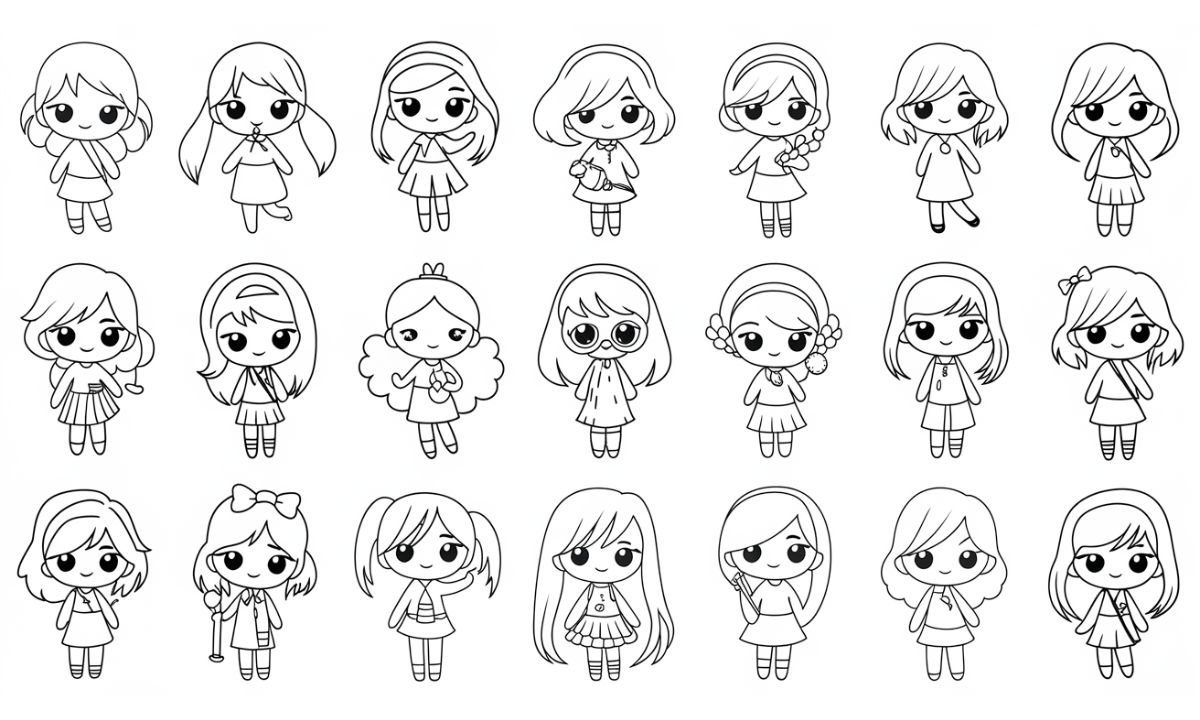Are you looking to add some adorable characters to your sketchbook? Chibi girl drawing ideas offer the perfect blend of cuteness and simplicity that make them approachable for artists of all skill levels.
From magical witches to sleeping cuties, this comprehensive guide will walk you through 29 cute and easy chibi girl drawing ideas that will spark your creativity and help you master this charming art style.
Whether you’re doodling in your spare time or creating content for social media, these chibi drawing ideas will give you plenty of inspiration. Let’s dive into the wonderful world of these pint-sized characters!
What is a Chibi?
Chibi (ちび) is a Japanese term meaning “small person” or “small child.” In the realm of art and animation, chibis are characterized by their exaggerated proportions – typically featuring oversized heads (often taking up about half of the character’s total height), tiny bodies, simplified facial features, and stubby limbs.
The chibi style originated in Japanese manga and anime as a way to depict characters in a more cute, simplified, and often comedic manner. The style has since gained tremendous popularity in the United States and worldwide, becoming a beloved art form for both beginners and experienced artists.
What makes chibi drawing particularly appealing to newcomers is its forgiving nature. The exaggerated proportions mean you don’t need to master realistic anatomy, and the simplified features allow artists to focus on conveying emotion and personality through minimal details.
“Chibi style is the perfect gateway into character design because it teaches you to focus on what really matters – personality and expression.” – Sarah Miller, Professional Illustrator
Key Features of Chibi Style:
- Head-to-body ratio of approximately 1:1 to 1:3 (compared to realistic proportions of 1:7 or 1:8)
- Large, expressive eyes (often taking up much of the face)
- Simplified or absent nose (often just a dot or small line)
- Small mouth that can change dramatically for expressions
- Tiny, simplified body with stubby limbs
- Minimal facial details but maximum emotional expression
Simple Chibi & Tutorial
Before jumping into specific chibi girl drawing ideas, let’s establish the basics with a simple tutorial. Creating a chibi character follows a different approach than drawing realistic figures, focusing more on cuteness than anatomical accuracy.
Basic Supplies for Chibi Drawing:
- Pencil (mechanical pencils work well for details)
- Paper (smooth paper is ideal)
- Eraser (kneaded erasers are gentle on paper)
- Fineliner pens (0.1-0.5mm for outlines)
- Markers, colored pencils, or digital tools for coloring
Step-by-Step Basic Chibi Construction:
- Start with the head – Draw a circle or slightly oval shape that will be about 1/3 to 1/2 of your total character height
- Add the body – Draw a small, simplified torso about half the height of the head
- Add limbs – Draw short, stubby arms and legs with simplified hands and feet
- Sketch facial features – Focus on large eyes, small nose, and simple mouth
- Add hair – Often exaggerated and flowing, hair helps define your chibi’s personality
- Detail clothing – Keep garments simple but recognizable
- Refine outline – Clean up your sketch and add final details
- Add color – Use bright, vibrant colors to enhance cuteness
Common Mistakes to Avoid:
- Making the body too large (chibi bodies should be tiny!)
- Adding too many facial details (simplicity is key)
- Creating stiff poses (chibis should look dynamic and lively)
- Overcomplicating clothing (keep designs readable at small scale)
Simple Girl
The basic standing chibi girl is the foundation upon which all other designs are built. This pose allows you to practice core chibi proportions while creating an adorable character that stands as a perfect starting point for beginners.
To create a simple chibi girl:
- Draw a large, circular head (approximately half the total height)
- Add a small torso (about half the size of the head)
- Attach short, stubby limbs
- Draw large, expressive eyes positioned low on the face
- Add a small, simple nose and mouth
- Create a basic hairstyle (bobs, pigtails, and ponytails work well)
- Dress your chibi in simple clothing (skirts, dresses, or shorts with t-shirts)
Pro Tip: The face is the most expressive part of a chibi. Focus on getting the eyes right, as they’ll do most of the emotional heavy lifting in your drawing.
Color Palette Suggestions for Classic Chibi Girls:
| Style | Primary Colors | Secondary Colors | Accent Colors |
| Cute | Pastel pink, baby blue | Lavender, mint green | White, gold |
| Sporty | Red, navy blue | White, gray | Black, yellow |
| Fantasy | Purple, teal | Silver, gold | White, black |
| Casual | Denim blue, forest green | Beige, brown | Red, yellow |
| Gothic | Black, purple | Deep red, dark gray | Silver, white |
Arms Crossed
The arms-crossed pose is perfect for expressing attitude and personality in your chibi girl drawings. This slightly more advanced pose helps convey confidence, defiance, or contemplation, adding character depth with a simple posture change.
To create an effective arms-crossed chibi:
- Draw your basic chibi with slightly wider shoulders than usual
- Position the arms crossing at the chest rather than the waist (due to chibi proportions)
- Make sure the hands peek out from opposite sides
- Tilt the head slightly or add a subtle body lean for extra attitude
- Match the facial expression to complement the pose (smirking, pouting, or raising an eyebrow)
Expression Suggestions for Arms-Crossed Chibis:
- Confident smile with raised eyebrow
- Pouty face with puffed cheeks
- Stern expression with narrowed eyes
- Shy smile with blushing cheeks
- Mischievous grin with gleaming eyes
Remember that chibi drawing ideas should always emphasize personality through exaggerated expressions and body language. The arms-crossed pose works particularly well for tsundere characters or any chibi girl with a bit of attitude!
Smiling Half Body
Half-body chibi drawings focus on the character from the waist up, allowing for more detail in the face, hair, and upper body while maintaining the adorable chibi style. This is perfect for artists who want to create expressive character portraits.
Creating a compelling smiling half-body chibi requires attention to:
- Facial expression – A genuine smile involves not just the mouth but also the eyes (slightly upturned or closed)
- Upper body posture – Slight shoulder lift or tilt to enhance the happy expression
- Hand gestures – Consider adding visible hands doing something characteristic (peace sign, thumbs up, holding an object)
- Clothing details – With fewer body parts to draw, you can add more detail to clothing
Tips for Creating an Authentic Chibi Smile:
- For a cute smile, use a simple curved line or small “v” shape
- Make eyes appear happy by adding slight upward curves to the bottoms
- For a bigger smile, use a “cat mouth” shape (^ω^)
- Add small blush circles on the cheeks to enhance cuteness
- Consider small dimples for extra charm
“The secret to drawing chibi expressions is understanding that less is more. A few simple lines can convey more emotion than complex details.” – Jun Oda, Manga Artist
Mini Chibi Doll
The mini chibi doll style takes the already adorable chibi concept and pushes it even further into the realm of cuteness. With an even larger head-to-body ratio and more simplified features, these tiny creations resemble collectible dolls or plushies.
Key Features of Mini Chibi Dolls:
- Extra-large head (up to 2/3 of total height)
- Ultra-simplified body (almost bean-shaped)
- Minimal limbs (sometimes just small nubs for hands and feet)
- Super simplified facial features (dots for eyes, tiny mouth)
- Accessory-focused details (bows, hats, tiny props)
This style works exceptionally well for:
- Sticker designs
- Charm accessories
- Social media icons
- Pattern designs
- Mascot characters
To create a mini chibi doll character, focus on creating a silhouette that’s recognizable even with minimal details. Color plays a crucial role here – use bright, contrasting colors to help define your character’s visual identity.
Little Lady
When your chibi drawing ideas need a touch of sophistication, the “little lady” approach offers a slightly more mature take while maintaining chibi cuteness. This style is perfect for creating chibi versions of elegant characters or for depicting slightly older girls.
To age up your chibi while keeping the cute factor:
- Maintain the large head but add slightly more refined facial features
- Elongate the body slightly (though still keeping it much shorter than realistic proportions)
- Add sophisticated clothing elements like collars, bow ties, jackets, or elegant dresses
- Style hair in more mature arrangements such as updos, styled bobs, or elegant long styles
- Include accessories like purses, jewelry, or glasses
Fashion Elements for Little Lady Chibis:
- Peter Pan collars
- Pleated skirts
- Cardigans over blouses
- Mary Jane shoes
- Small handbags
- Berets or wide-brimmed hats
- Pearl accessories
This style blends the adorable appeal of chibi art with touches of elegance, creating characters that feel charming and sophisticated simultaneously.
Witch
Magical-themed chibi girl drawing ideas are wildly popular, and witch chibis offer the perfect blend of spooky and sweet! These enchanting characters combine traditional witch elements with the cuteness of the chibi style.
Essential Witch Chibi Elements:
- Pointy witch hat (often oversized for chibi proportions)
- Broomstick (can be held or ridden)
- Magical familiar (small companion animal like a cat, bat, or owl)
- Potion bottles or spell books as accessories
- Magic wand or staff
- Cape or cloak (simplified for chibi proportions)
When coloring witch chibis, consider these effective color schemes:
- Traditional: Black, purple, orange accents
- Pastel witch: Lavender, mint green, baby blue
- Elemental witch: Colors representing fire, water, earth, or air
- Seasonal witch: Colors reflecting spring, summer, fall, or winter themes
Cute Spell-Casting Poses for Witch Chibis:
- Stirring a cauldron with determined expression
- Floating on a broomstick with cape billowing
- Reading from a giant spellbook with concentrated face
- Mixing potions with scientific precision
- Holding a wand with magical effects surrounding
Sakura Chibi
Cherry blossom (sakura) themed chibis blend Japanese cultural elements with the adorable chibi style. These spring-inspired characters feature pink tones, floral motifs, and an overall sense of delicate beauty.
To create a compelling sakura chibi:
- Base your color palette on cherry blossoms – soft pinks, whites, and light greens
- Incorporate floral elements in clothing design (petal-shaped collars, flower patterns)
- Add sakura flowers in the hair or as accessories
- Include traditional Japanese clothing elements like kimono details or hakama-inspired designs
- Create a spring atmosphere with floating petals surrounding your character
Sakura Chibi Color Palette:
| Element | Colors |
| Hair | Pink, black, brown with pink highlights |
| Clothing | Soft pink, white, sage green, cherry red |
| Skin | Pale peach |
| Accessories | Pink gradients, white accents, light brown |
| Background elements | Petal pink, sky blue, grass green |
For extra effect, add delicate lines of floating petals around your sakura chibi, creating the impression of cherry blossoms carried on a spring breeze. This style is particularly popular for seasonal art and works beautifully for characters with gentle, kind personalities.
Mushroom Princess
Fantasy-themed chibi drawing ideas offer unlimited creativity, and the mushroom princess design combines whimsical forest elements with royal flair. These woodland royalty characters feature fungus-inspired designs that are surprisingly adorable in chibi form.
Key Elements of Mushroom Princess Chibis:
- Mushroom cap hat or hair (often red with white spots for fly agaric inspiration)
- Forest-inspired clothing in earthy tones with fungal textures
- Small woodland accessories like acorns, leaves, or berries
- Nature-themed staff or wand topped with a mushroom
- Optional small forest creature companion
Color Combinations for Mushroom Themed Chibis:
- Classic: Red and white with forest green accents
- Fantasy: Purple and blue mushroom elements with silver details
- Autumn: Orange and brown with golden accessories
- Poison: Vibrant green and purple with black details
- Fairy: Pastel pink and blue with glowing elements
To enhance the woodland theme, consider placing your mushroom princess chibi in a setting with:
- Oversized grass and flowers
- Dewdrops and morning mist
- Larger mushrooms as environmental elements
- Tiny forest animals or insects
- Soft dappled lighting effects
Mini Sakura
Taking the sakura theme to an even smaller scale, mini sakura chibis are ultra-simplified versions that maintain the cherry blossom aesthetic while being absolutely tiny! These micro-sized characters work wonderfully for:
- Journal decorations
- Margin doodles
- Pattern elements
- Social media emoji-style art
- Small decorative elements on larger pieces
When creating mini sakura chibis:
- Simplify to essential elements only – perhaps just a circle head, dot eyes, and a simple body
- Use color as your main identifier – pink and white become crucial for recognition
- Add one defining sakura element – like a single blossom on the head
- Use thinner lines for these smaller characters
- Group them together for greater impact
Pro Tip: When working at a very small scale, consider using gel pens or fine-tipped markers that allow for precise details, or create them digitally where you can zoom in for precision.
Sitting Chibis
Sitting poses add variety to your chibi girl drawing repertoire and allow for cute scenarios like tea parties, classroom scenes, or relaxing moments. The sitting position emphasizes the chibi’s small size and enhances their adorable quality.
Creating Effective Sitting Chibi Poses:
- Start with the seated head position – usually at the same height as a standing chibi
- Draw a simplified sitting body – remember that chibi legs are very short when extended
- Position the arms appropriately (on lap, supporting weight, or engaging in activity)
- Add details to show interaction with the sitting surface (slight weight impression, etc.)
- Consider the sitting style that matches your character’s personality
Different Sitting Styles for Chibis:
- Formal – Knees together, back straight, hands on lap
- Casual – Cross-legged, possibly leaning on one arm
- Playful – Legs extended forward, perhaps kicking lightly
- Relaxed – Lounging back, supported by arms
- Cute – Knees pulled up to chest, hugging legs
Remember to adjust clothing to the sitting position – skirts will spread out, pants will bunch at the knees, and long capes or hair might pool around the character.
Common Mistakes to Avoid:
- Not accounting for the surface the chibi is sitting on
- Making legs too long when extended
- Forgetting to adjust clothing to the seated position
- Creating an unnatural-looking balance
Laying Chibi
Horizontal poses add dimension to your chibi girl drawing ideas collection. These reclining characters can be shown relaxing, sleeping, reading, or simply lounging in adorable positions.
Creating an effective laying chibi requires attention to:
- Body orientation – Usually shown from side view or three-quarter perspective
- Support points – How the body interacts with the surface it’s laying on
- Gravity effects – How hair, clothing, and accessories respond to the horizontal position
- Facial expression – Often relaxed, sleepy, or concentrated on an activity
Tips for Natural-Looking Laying Chibis:
- Position the head slightly elevated or supported by an arm/pillow
- Show slight compression where body meets the surface
- Allow hair to spread out naturally if the character is lying on their back
- For side-lying poses, consider adding small details like bent knees or curled toes
- Add environment elements like blankets, grass, or beach sand
Expression Ideas for Resting Chibis:
- Peaceful closed eyes
- Dreamy gaze upward
- Focused reading expression
- Lazy smile
- Contented sleeping face
Happy Sleeping
Few chibi drawing ideas are as universally appealing as sleeping poses. These peaceful characters exude tranquility and comfort while maintaining the signature chibi cuteness.
To create adorable sleeping chibi girls:
- Position the character in a comfortable sleeping pose (curled up, spread out, or hugging a pillow)
- Create a peaceful facial expression – gently closed eyes, small mouth (possibly with a tiny drool bubble for humor)
- Add sleep indicators like “z” bubbles, stars, or thought bubbles with dreams
- Design cute pajamas appropriate to your character’s personality
- Include comfort items like pillows, blankets, stuffed animals, or sleeping masks
Cute Pajama Ideas for Sleeping Chibis:
- Animal onesies (cat, rabbit, dinosaur)
- Traditional button-up pajama sets with patterns
- Oversized t-shirts with cute prints
- Two-piece sets with shorts/pants and camisoles
- Nightgowns with lace or ribbon details
For extra cuteness, consider showing your sleeping chibi hugging a favorite plushie or with slightly messy bed-head hair. The contrast between peaceful sleep and their normally energetic chibi nature creates an endearing effect.
Running Chibi
Dynamic poses bring chibi characters to life, and running poses are perfect for conveying energy and movement. These action-oriented chibi girl drawing ideas add excitement to your artwork.
Creating convincing running chibis involves:
- Positioning the body in mid-stride – one leg forward, one back
- Creating arm positions that counterbalance the legs (opposite arm and leg forward)
- Tilting the body slightly forward to suggest momentum
- Adding motion lines behind the character
- Creating a facial expression that matches the running motivation
Expression Ideas for Running Chibis:
- Determined – Focused eyes, set mouth
- Excited – Wide smile, sparkling eyes
- Scared – Wide eyes, open mouth, possibly tears flying
- Late – Panicked expression, possibly toast in mouth (anime trope)
- Joyful – Closed eyes, big smile
Elements to Enhance Movement:
- Motion lines trailing the character
- Slightly blurred effects behind the chibi
- Dust clouds at the feet
- Flying/trailing hair and clothing elements
- Environmental reactions (startled birds, rustling grass)
Simply Standing
Though it might seem basic, mastering the standing chibi pose is fundamental to chibi art. A well-executed standing pose establishes character personality and serves as the foundation for more complex positions.
To perfect your standing chibi girl drawings:
- Establish a clear line of balance from head through body to feet
- Position feet appropriately for stability (usually slightly apart)
- Create a stance that reflects personality (wide for confident, narrow for shy)
- Add subtle weight shift to one hip for a more natural pose
- Position arms in character-appropriate gestures
Standing Poses That Convey Personality:
- Confident: Hands on hips, feet apart, chin slightly raised
- Shy: Feet close together, hands clasped in front, slight body turn
- Playful: One foot slightly raised, arms in dynamic position
- Formal: Straight posture, hands at sides or clasped in front
- Casual: Weight on one leg, relaxed arm position
Remember that even in a basic standing pose, every element should contribute to expressing your chibi’s unique character. Small details like the tilt of the head or the position of the hands can transform a simple pose into a personality showcase.
2 Head Cutie
The ultra-deformed “2 head tall” chibi style pushes cuteness to the extreme by creating characters that are literally just two head-heights tall. This exaggerated style is perfect for maximum adorableness and works especially well for:
- Mascot characters
- Emoji-style art
- Merchandise designs
- Chibi versions of existing characters
- Comic relief illustrations
Key characteristics of 2-head chibis:
- Head takes up approximately 50% of total height
- Body is extremely simplified (often just a small oval or rectangle)
- Limbs are minimal stubs or simplified shapes
- Facial features dominate the design
- Recognizable elements (like hair or clothing) are exaggerated
When drawing in this extreme style:
- Focus on instant recognition – what makes this character immediately identifiable?
- Simplify to essential elements only
- Use color and shape as your primary tools
- Exaggerate the most characteristic features
This ultra-cute style is perfect when you want maximum adorableness with minimum complexity in your chibi girl drawing ideas.
Idol Chibi
Pop star and idol-themed chibis combine performance energy with chibi cuteness. These sparkly, dynamic characters are perfect for fans of music and performance art.
To create compelling idol chibi girls:
- Design eye-catching stage outfits – bold colors, interesting textures, and performance-ready details
- Create dynamic performance poses – microphone in hand, dance positions, or dramatic gestures
- Add stage elements – spotlights, microphone stands, stage platforms
- Style hair in dramatic performance-ready styles – often with accessories like headsets or decorative clips
- Include idol-specific props – light sticks, microphones, instruments
Popular Idol Outfit Elements for Chibis:
- Pleated mini-skirts
- Sailor-style collars
- Frilly blouses
- Decorative ties or bows
- Platform boots
- Fingerless gloves
- Statement jewelry
- Character-specific color schemes
For maximum impact, position your idol chibi in mid-performance with sparkle effects, motion lines, or music notes surrounding them. Consider creating a group of idol chibis to form a complete performance unit!
Sleeping
While we covered happy sleeping chibis earlier, this section focuses specifically on creating varied sleeping positions and scenarios for your chibi girl drawing ideas.
Different Sleeping Positions for Chibi Characters:
- Curled up – Knees pulled up, arms tucked in
- Sprawled out – Arms and legs extended
- Side sleeper – Lying on side, often with hands under head
- Tummy sleeper – Face down, often with arms above head
- Back sleeper – Face up, arms at sides or across chest
To enhance sleeping chibi drawings:
- Create distinctive “sleep bubbles” – traditional Zs, dream clouds, or thought bubbles
- Add dream content inside thought bubbles that reflect the character’s personality
- Include environmental elements like beds, hammocks, desks (for accidental napping), etc.
- Design character-appropriate sleepwear
- Consider sleep quality in facial expression (peaceful, troubled, drooling humorously)
“Sleeping chibis capture that perfect blend of vulnerability and cuteness that makes the art style so appealing.” – Amy Chen, Character Designer
Walking
Walking poses add natural movement to your chibi repertoire. These poses are less dynamic than running but show your character in natural motion.
Creating effective walking chibi girls involves:
- Positioning legs in mid-step – one slightly forward, one back
- Creating natural arm swing – opposite to leg movement
- Adding slight forward lean for momentum
- Designing clothing that responds to movement – slight flow or swing
- Creating a facial expression appropriate to the walking purpose
Tips for Enhancing Walking Poses:
- Add subtle motion lines behind the moving limbs
- Show slight hair movement in the direction opposite to travel
- Create small environment interactions (puddle splashes, leaves rustling)
- Position accessories (bags, purses) with appropriate swing
- Consider destination elements that explain the walking purpose
For additional interest, consider the walking surface and how it affects the character’s gait – are they walking on pavement, sand, mud, or something else entirely?
Colored Chibi
Bringing your chibi girl drawing ideas to life with color adds another dimension of personality and appeal. Effective coloring techniques enhance the character while maintaining the chibi style’s charm.
Color Theory Basics for Chibi Art:
Color Harmony Approaches:
- Complementary colors – opposites on the color wheel create vibrant contrasts
- Analogous colors – colors adjacent on the wheel for harmonious looks
- Triadic colors – three colors evenly spaced on the wheel for balanced but vibrant designs
- Monochromatic – variations of a single color for elegant, cohesive looks
- Split complementary – one color plus two adjacent to its complement for sophisticated balance
Chibi-Specific Coloring Tips:
- Use slightly more saturated colors than realistic art to enhance the cute factor
- Create clear color separation between elements for readability
- Consider color psychology for character personality (red for energy, blue for calm, etc.)
- Use color blocking for simplified shading rather than complex gradients
- Add small color accents in unexpected places (hair highlights, accessory details)
Simple Shading Techniques for Chibis:
- Cell shading (hard-edged shadows)
- Simple two-tone shading (light and shadow only)
- Blush marks on cheeks, knees, and elbows for cuteness
- Light reflections in the eyes (white dots or shapes)
- Hair highlights to suggest dimension
Butterfly Chibi
Butterfly-themed chibis combine insect beauty with human characteristics, creating magical hybrid characters. These fantasy designs are perfect for spring themes or magical character concepts.
To create butterfly chibi girls:
- Design butterfly wings that complement the character’s color scheme
- Position wings appropriately – usually from the back, visible around the sides
- Consider wing transparency effects using lighter colors or opacity settings
- Add antennae as hair accessories or emerging from the head
- Incorporate butterfly patterns into clothing and accessories
Poses That Showcase Wings:
- Standing with wings spread wide
- Floating/flying with arms outstretched
- Dancing with wings in gentle motion
- Sitting with wings folded behind
- Twirling to create wing movement
For coloring, research actual butterfly species for inspiration. Monarch butterflies, blue morphos, painted ladies, and swallowtails all offer stunning natural color palettes you can adapt for your chibi designs.
Butterfly Elements to Incorporate:
- Wing patterns (spots, stripes, eyespots)
- Antennae (straight, curved, or clubbed)
- Proboscis (can be stylized as a cute curled accessory)
- Segmented body elements
- Iridescent or sparkly effects
Cute Trio
Group compositions add narrative and relationship dynamics to your chibi girl drawing ideas. A trio of chibi characters allows for interaction while remaining manageable to draw.
To create an effective chibi trio:
- Establish visual variety – different heights, body types, hair styles, clothing styles
- Create a unified theme – matching elements that connect the characters
- Position characters to show relationships – close friends might have arms linked, rivals might face different directions
- Balance the composition – arrange characters in a pleasing grouping
- Show interaction through gestures, gazes, or shared activities
Theme Ideas for Chibi Trios:
- Seasonal (spring, summer, fall characters)
- Elemental (fire, water, earth powers)
- Color-based (primary colors, pastel palette)
- Activity groups (sports team, music band, study group)
- Fantasy roles (warrior, mage, healer)
When designing a trio, consider how each character’s personality complements or contrasts with the others. This relationship dynamic adds storytelling depth to your chibi art.
Sheep Chibi
Animal-themed chibis blend human and animal characteristics, with sheep-themed designs offering particularly fluffy cuteness. These wooly characters work well for zodiac art, farm themes, or simply adorable character designs.
To create sheep-inspired chibi girls:
- Incorporate sheep ears – usually rounded and positioned on top of the head
- Add wool elements – fluffy hair, collar, cuffs, or full costume
- Include small horns for ram-inspired designs (optional)
- Design sheep-themed clothing – perhaps a wool dress or sweater
- Add sheep accessories – bell necklace, hoof-shaped shoes, etc.
Techniques for Creating Fluffy Textures:
- Short, curved lines for wool puffs
- Cotton ball-like shapes clustered together
- Soft, rounded edges without hard lines
- Light and shadow patterns to suggest fluffiness
- Textured brushes for digital art
The color palette typically includes:
- Cream, white, and off-white for wool elements
- Pink for ears and accessories
- Black for hooves or accents
- Pastel colors for clothing elements
Jellyfish Chibi
For unique chibi girl drawing ideas, jellyfish-inspired designs offer ethereal, otherworldly appeal. These ocean-themed chibis combine the transparent beauty of jellyfish with human characteristics.
To create jellyfish chibi girls:
- Design a translucent dome or bell shape as a hat or hair element
- Create tentacle-like extensions for hair or clothing elements
- Incorporate flowing, ribbon-like structures reminiscent of jellyfish tentacles
- Use transparency effects in coloring
- Add bioluminescent details that appear to glow
Color Schemes Inspired by Real Jellyfish:
- Crystal jellyfish: Transparent with light blue highlights
- Moon jellyfish: Translucent white with purple/pink accents
- Purple-striped jellyfish: Purple and lavender patterns
- Lion’s mane: Orange-red with longer elements
- Blue bottle: Vivid blue with darker blue accents
For maximum effect, consider placing your jellyfish chibi in an underwater setting with bubbles, water effects, and other sea creatures. The contrast between the cute chibi style and the alien nature of jellyfish creates a fascinating character hybrid.
Wrap Up
We’ve explored 29 cute and easy chibi girl drawing ideas that range from simple standing poses to fantastical hybrid creatures. Each style offers unique opportunities to express creativity while maintaining the adorable chibi aesthetic that makes these characters so beloved.
As you develop your chibi drawing skills, remember:
- Experiment with different styles – from ultra-deformed 2-head chibis to more proportioned “little lady” designs
- Combine elements from different ideas – perhaps a jellyfish witch or a butterfly idol?
- Develop your personal chibi style by consistently practicing your favorite elements
- Use reference images for complex poses or specific themes
- Share your creations with the chibi art community for feedback and inspiration
Community Resources for Chibi Artists:
- Instagram hashtags: #chibiart #chibigirlart #cutechibidrawings
- Reddit communities: r/AnimeART, r/Chibi, r/learntodraw
- Discord servers dedicated to anime and chibi art styles
- YouTube tutorials for specific chibi techniques
Final Tips for Developing Your Chibi Style:
- Study chibi proportions from established artists
- Practice exaggerating expressions for maximum impact
- Focus on creating distinctive silhouettes
- Develop a signature element that makes your chibis recognizable
- Remember that simplicity is key to effective chibi design
Whether you’re creating chibi girl drawing ideas for fun, social media, or professional projects, the chibi style offers endless creative possibilities while remaining accessible to artists of all skill levels. From simple beginnings, you can develop a whole world of adorable characters with unique personalities and stories.
Now grab your pencil and start creating your own army of adorable chibi girls!










